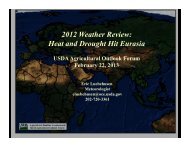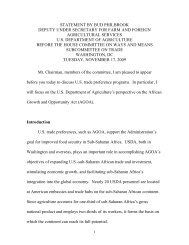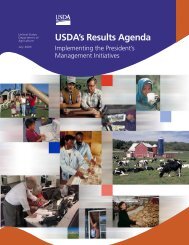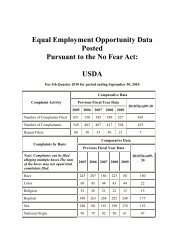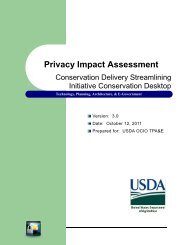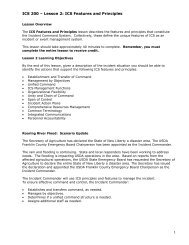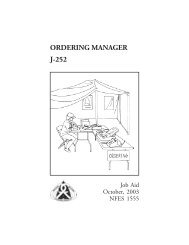USDA 2007 Farm Bill Proposals - US Department of Agriculture
USDA 2007 Farm Bill Proposals - US Department of Agriculture
USDA 2007 Farm Bill Proposals - US Department of Agriculture
Create successful ePaper yourself
Turn your PDF publications into a flip-book with our unique Google optimized e-Paper software.
STRENGTHEN PAYMENT AND ELIGIBILITY LIMITSRecommendation in BriefReform farm program payment limits, eligibility requirements, and attribution to reducepayments going to larger and higher income producers, increasing overall equity in farmprograms.Problem<strong>Farm</strong> program payments account for a sizeable share <strong>of</strong> farm income for producers <strong>of</strong> programcrops. Generally, the effect <strong>of</strong> payment limits has been limited because producers have been ableto use various legal and regulatory provisions to avoid being restricted by these limits. TheCommission on the Application <strong>of</strong> Payment Limitations for <strong>Agriculture</strong> authorized in the 2002farm bill found the “limits on marketing loan benefits are not effective, only a small percentage<strong>of</strong> program crop producers reach the current limits on direct and counter-cyclical payments, andmany <strong>of</strong> the largest farms have either restructured or are likely to do so to lessen the extent towhich the limits reduce payments.”With only limited constraints on payments, a substantial portion <strong>of</strong> payments go to large, highincome producers. In 2005, commercial farms (defined as a farm with sales <strong>of</strong> $250,000 or more,where the principal occupation <strong>of</strong> the operator is farming) accounted for nine percent <strong>of</strong> all farmsbut received 54 percent <strong>of</strong> all government payments, averaging $54,100 per farm. These farmshad average household incomes <strong>of</strong> $200,000. <strong>Farm</strong>s where the principal occupation <strong>of</strong> theoperator was farming and with sales up to $250,000 (intermediate farms) accounted for 23percent <strong>of</strong> farms and received 27 percent <strong>of</strong> all payments, averaging $8,700 per farm. Thesefarms had average household incomes <strong>of</strong> $68,000. The U.S. average household income was$63,344 in 2005. These data indicate most payments go to farm households that have largeincomes compared with other farms and with U.S. average household income. Moreover, theselarge payments are likely to provide a means and incentive for the “big to get bigger” and outbidtheir neighbors in purchasing and renting farmland.The problem was highlighted in the comments <strong>of</strong>fered during many <strong>Farm</strong> <strong>Bill</strong> Forums. Kristinafrom Virginia said, “<strong>Farm</strong> bill policies are supposed to preserve family farms, but theydisproportionately channel money to big agribusiness.” Steve from Georgia said, “These peopledrawing these multiple payments are in competition against us… They… keep getting biggerevery year. The number <strong>of</strong> farmers drops every year. There's going to be fewer and fewerfarmers, and there won't be such a thing as a family farm.”Recommended SolutionThe Administration proposes increasing the effectiveness <strong>of</strong> farm bill payment limits and helpingassure equity among farmers.1. Decrease the Adjusted Gross Income (AGI) eligibility cap for all farm commodity programpayments from the current $2.5 million to $200,000 annually. Continue current law AGIrequirements and payment limits on all conservation title payments.<strong><strong>US</strong>DA</strong> <strong>2007</strong> <strong>Farm</strong> <strong>Bill</strong> <strong>Proposals</strong> Page 21 <strong>of</strong> 183




